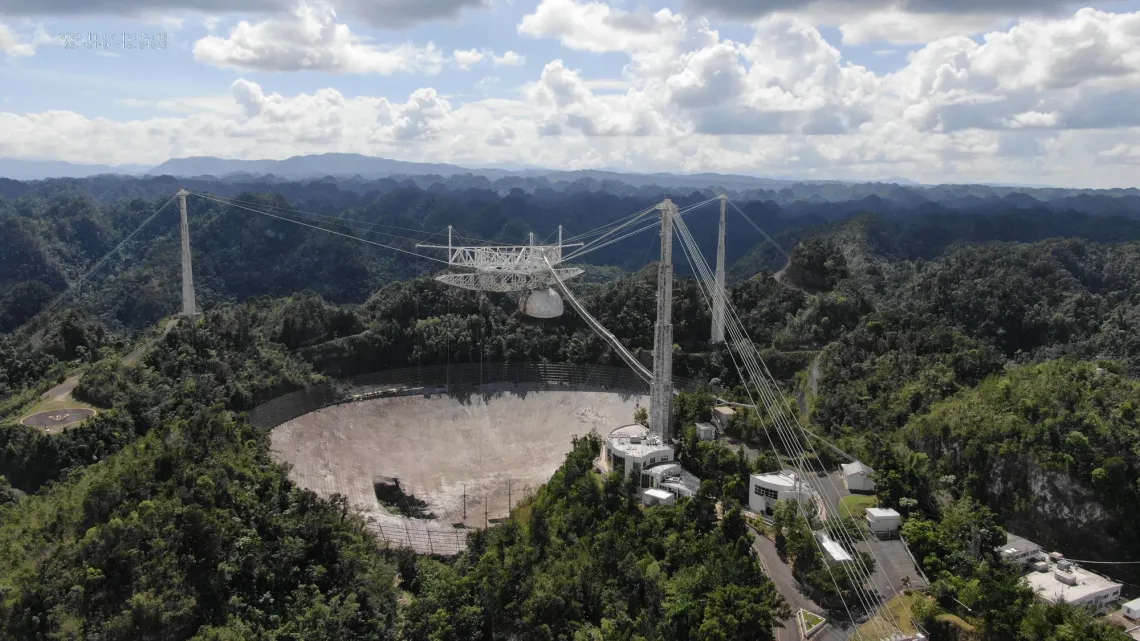Lamenting the Loss of the Arecibo Observatory
Nov. 23, 2020
Arecibo Observatory’s iconic radio telescope, which has bridged earth and sky from its base in Puerto Rico for 57 years, is to be dismantled, having sustained irreparable damage.
Image

Arecibo Observatory's 305-meter telescope in November of 2020.
University of Central Florida
The news beamed through the astronomy and space community on Nov. 19, causing a profound and collective gasp of loss. Arecibo Observatory’s iconic radio telescope, which has bridged earth and sky from its base in Puerto Rico for 57 years, is to be dismantled, having sustained irreparable damage.
For the many individuals who started and built their careers using Arecibo, this loss is felt viscerally. But for all of us, the loss of a magnificent large-scale science asset is a gut-shot because we know how hard it is to marshal the forces to build and operate Big Science instruments.
Here at the University of Arizona, several astronomers and space and planetary scientists cut their teeth in their chosen fields and conducted research, in some cases for years, at Arecibo. Several UArizona students who earned their PhDs and at least two current students are alumni of the Arecibo undergraduate research program. Michael Nolan, now at UArizona’s Lunar and Planetary Laboratory (LPL), served as its director before arriving in Tucson. They, along with their colleagues around the world, understand well the unique role the telescope has held in radio astronomy, planetary science, and atmospheric research, and the hole its absence will create.
The telescope consists of a 305-meter (1,000-foot) radio dish with a 900-ton instrument platform suspended by cables. The National Science Foundation announced last week that it will begin to decommission the telescope after engineers determined that damage to the structure, including two broken cables, cannot be stabilized without risk to human safety.
The observatory is an NSF facility once operated by Cornell University and now managed by the University of Central Florida in collaboration with Universidad Ana G. Méndez and Yang Enterprises Inc. As the world’s largest planetary radar system, the observatory undertook a broad range of science, from studying gas (the clouds of molecular and atomic elements from which stars form) in other galaxies to asteroids in our solar system.
Arecibo also has created an international community of staff and students – past and present, ensuring world-class and Nobel prize-winning science, and it has been culturally, academically, and economically significant to Puerto Rico.
We at UArizona are grateful for its scientific capabilities and long and steady history as a key component in our network of knowledge.
Drs. Nolan and Ellen Howell, also of LPL, have been part of an international team of asteroid observers at the observatory, and both are part of the OSIRIS-REx asteroid sample return mission, led by UArizona, which collected a sample from asteroid Bennu last month.
In December 2018, a team of scientists led by Dr. Howell used Arecibo – the only radar facility with the sensitivity to acquire images of Comet 46P/Wirtanen’s nucleus – during the comet’s flyby. This allowed scientists to see the size and rotation characteristics of the nucleus.
Alessondra “Sondy” Springmann, a Ph.D. candidate in LPL, lists among her past work two years of asteroid and comet radar observations at Arecibo Observatory. She also investigated thermal properties of meteorite analogues for the OSIRIS-REx mission and currently studies Arecibo radar observations of Comet 45P/Honda–Mrkos–Pajdušáková.
I lament the demise of Arecibo, as do all researchers who have reached for the stars and beyond through its telescope to expand our knowledge of our universe. In an era of ever-astounding accomplishments in asteroid and planetary space research, it is my hope that the nation can bring our innovation, technology, expertise, and resources to bear to fill the void.

